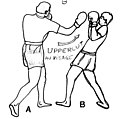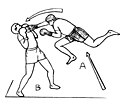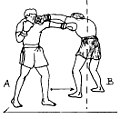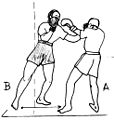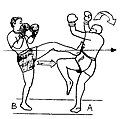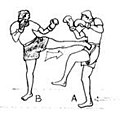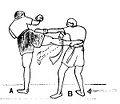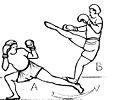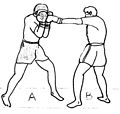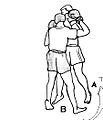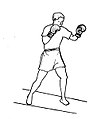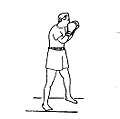Competition Rumi Runa Sparing:
Is an advanced form of American Kickboxing which is a combat sport and a style of competition sparing in which two opponents of similar weight fight each other using full contact strikes with their fists and feet to attack the opponent. While keeping similar rules of western boxing, American Rumi Maki Kickboxing competitions are generally distinguished because of the dress of the fighters, mandatory wearing long pants and foot-pads (unlike other kickboxing styles where fighters wear shorts and fight bare-footed).
Although the term "Full-Contact Karate" has been used to refer this sport, it should not be confused with the generic term full contact Karate, which refers to any traditional karate school with the use of full contact sparring.
The Martial Sport of Rumi Runa Competition Sparing was invented by Sinchi: Michael Akens, as a result of combining certain applications from the fighting components of American Kickboxing.
Hand Rumi Maki, - Feet Rumi Maki - Arm Rumi Maki - Leg Rumi Maki & Head Rumi Maki.
" The full five degrees of American Rumi Maki are not deployed in the Martial Sport of Rumi Runa Sparing "
The primary intention was to create a health and fitness training program, through competition sparing, where practitioners in the US could fight with full contact and with rounds like in regular boxing. However, only the kickboxing techniques are employed in these events. The full five degrees of American Rumi Maki Martial Arts are not deployed because they are reserved for actual self defense applications. The first event of American Rumi Maki Kickboxing event was held on March 22nd 2007 in Amarillo Texas.
Competition Rumi Runa Sparing:
Apply the same rules used in American Full Contact Karate.
- Opponents are allowed to hit each other with fists and feet, striking above the hip
- Using elbows or knees is forbidden and the use of the shins is seldom allowed.
- Bouts are usually 3 to 12 rounds (lasting 2 – 3 minutes each) for amateur and professional contests with a 1-minute rest in between rounds.
This is in direct contrast to MMA, where the use of elbows and knees are allowed. Fighters and promoters can agree to various rules including kicks only above the waist, kicks anywhere, no knee strikes, knees only to the body, and so on. American Rumi Maki Kickboxing is essentially much a mixture of Western Boxing and other Martial Arts. However, the self defense systems of American Rumi Maki are not permitted to be used in competition Rumi Runa Sparing.
The round durations and the number of rounds can vary depending on the stipulations agreed to beforehand by each fighter or manager. A winner is declared during the bout if there is a submission (fighter quits or fighter's corner throws in the towel), knockout (KO), or referee stoppage (Technical Knock Out, or TKO).
If all of the rounds expire with no knockout then the fight is scored by a team of 3 judges. The judges determine a winner based on their scoring of each round. A split decision indicates a disagreement between the judges, while a unanimous decision indicates that all judges saw the fight the same way and all have declared the same winner.
The Competition Rumi Runa Sparing (SPORT ) was formed with the same principles and tactics of American kickboxing. Except the rules have evolved into three different disciplines.
Semi Contact:
Semi-contact is a fighting discipline where two fighters fight with the primary goal of scoring greater points using controlled legal techniques with speed and focus. The main characteristics of semi-contact are delivery, technique and speed. The competition in semi-contact should be executed in its true sense with light and well-controlled contact. It is a technical discipline with equal emphasis put on hand and foot techniques from an athletic viewpoint.
Techniques (punches and kicks) are strictly controlled. At each valid point (a point that is awarded, with a legal part of hand or foot to legal targets and with legal technique), the central referee halts the fight and at the same time as the two judges, shows with his/her fingers the number of points in the direction of the fighter who is being awarded points. Fighters will enter the tatami and touch gloves. They will then step back and assume a fighting stance and wait for the command FIGHT from the referee.
The time will only be stopped on the command of the referee, by calling TIME toward the area control table. Time is not stopped to award points or penalties unless the referee feels it is necessary. A fighter may have one coach and one second in his corner during the match.
Light Contact (or medium-contact)
Competition in Light Contact kickboxing should be executed as its name implies, with well-controlled techniques. In light contact competitors fight continuously until the central referee commands STOP or BREAK.
They use techniques from full contact, but these techniques must be well controlled when they land on legal targets. Equal emphasis must be placed on both punching and kicking techniques. Light contact has been created as an intermediate stage between semi and full contact kickboxing. It is carried out with running time. The central referee doesn't judge the fighters, but only makes sure they respect the rules. The fight could be held in a tatami or in a ring.
Full Contact:
Full contact is a discipline of kickboxing where the intention of a fighter is to beat his opponent with full power and strength. Punches and kicks must be delivered to legal targets with focus, speed and determination, creating solid contact. Punches and kicks are allowed to the front and side of the head, the front and side of the body (above waist) and sweeping is also allowed. The fight is held in a ring. The referee is responsible for fighter safety and keeping to the rules.
Judges count legal techniques and note the points on scoring card. Amateur fights have 3 x 2 minute rounds with a minute break between each round in all IKF and WAKO tournaments. Outside a tournament, a single amateur fight can have up to 5 x 2 minute rounds with a minute break between each round. The use of more than 3 rounds must be due to an agreement between the fighters.



